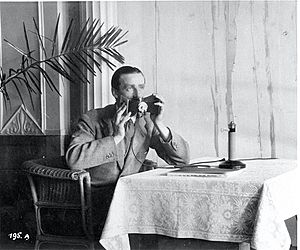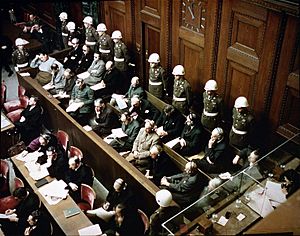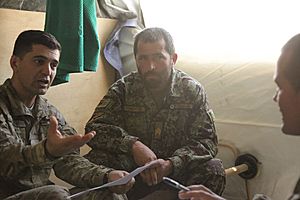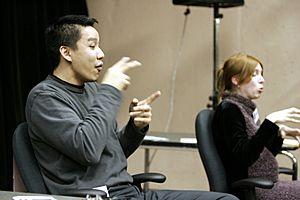Language interpretation facts for kids
Interpreting is like being a language bridge! It's when someone listens to what is said in one language and then quickly says it in another language. This happens right away, or very soon after.
The two main ways of interpreting are:
- Simultaneous interpreting: The interpreter translates at the same time as the speaker.
- Consecutive interpreting: The interpreter waits for the speaker to pause before translating.
People have been interpreting for a very long time, even before writing was invented! But interpreting as a special job only became common less than 100 years ago.
Contents
A Look Back: The History of Interpreting
How We Learn About Interpreting's Past
Learning about the history of interpreting is quite new. For a long time, most studies focused on interpreters at big meetings. Not much was written about how interpreting was done in the past.
Even though interpreting has happened for thousands of years, there are not many old records about it. Interpreters and their work usually didn't get written into history books. One reason is that written words were often seen as more important than spoken words. Another reason is that interpreting was sometimes seen as just a simple helper job. Also, interpreters were not always treated fairly by writers and historians.
We often find out about past interpreting from old letters, diaries, and stories. Many of these documents only mention interpreting by chance.
What Does "Interpreter" Mean?
Many languages have words for "interpreting" and "interpreter." Some words in German, Scandinavian, and Slavic languages come from an ancient language called Akkadian, around 1900 BCE.
The English word "interpreter" comes from the Latin word interpres. This word means 'someone who explains what is unclear'. Some people think it relates to words meaning 'price' or 'middleman', like someone who helps with trade.
Different Ways to Interpret
Consecutive Interpreting
In consecutive interpreting, the interpreter waits for the speaker to stop talking before they start translating. This means it takes much more time, sometimes twice as long. The interpreter usually sits or stands close to the speaker.
Interpreters can translate in short parts or long parts. For short parts, they mostly use their memory. For longer parts, they often take notes. These notes must be clear so the interpreter can read them quickly. It's best to interpret whole ideas, not just small pieces. This helps make the translation more accurate and easier to understand.
Sometimes, interpreters need to do "sight translation." This is when they read a document in one language and translate it out loud into another language as if it were written in that second language. This often happens in courts or hospitals.
Consecutive interpreting is often used when people want to hear both the original speech and the translation. It's also used in courtrooms where both versions need to be recorded.
If an interpreter can't translate directly between two languages, another interpreter might help. For example, a Greek speaker might be translated into English, and then that English is translated into another language. This is called "double-interpretation." Sometimes, even "triple-interpretation" is needed for rare languages. This type of interpreting works best with consecutive interpreting.
Simultaneous Interpreting
Simultaneous interpreting (SI) means the interpreter translates at the same time as the speaker. This saves a lot of time and doesn't interrupt the speaker's natural flow. Software can also do SI, listening and speaking the translation at the same time. The most common type is when the interpreter hears the message for the first time as they translate it.
Simultaneous interpreting using special electronic equipment was first used at the Nuremberg trials in 1945. This equipment allowed many people to listen, and translations were offered in French, Russian, German, and English. The technology was developed in the 1920s and 1930s by Edward Filene and Alan Gordon Finlay with IBM. It was so successful that IBM sold the equipment to the United Nations, where it is still widely used today.
In the best setup, the interpreter sits in a sound-proof booth. They speak into a microphone while listening to the speaker through earphones. The listeners then hear the translation through their own earphones.
The Change from Consecutive to Simultaneous
In the 1800s, interpreters were rarely needed for European diplomatic talks. This was because most diplomats could speak French. After World War I, more interpreting was needed because leaders like U.S. President Woodrow Wilson and British Prime Minister David Lloyd George did not speak other languages. At that time, simultaneous interpreting equipment didn't exist, so consecutive interpreting was used.
Consecutive interpreters used special note-taking systems with symbols and abbreviations to be accurate. They had to wait until the speaker finished. Then, they would create a smooth translation, sometimes for half an hour, based on their notes.
After World War II, simultaneous interpreting became more accepted, especially at the Nuremberg trials. Some experienced consecutive interpreters worried that translating and listening at the same time would lead to mistakes. They also didn't like that they would be speaking from hidden booths instead of being visible speakers.
In 1951, the United Nations added more official languages. Consecutive interpreting became too slow for large meetings. So, simultaneous interpreting became the main method for big UN meetings. Consecutive interpreting is still used for smaller discussions where a smoother translation is preferred.
Technology Helping Interpreters
New tools are being developed to help interpreters. These tools can include glossaries (lists of terms) and even automated speech recognition.
Whispered Interpreting
Whispered interpreting is called chuchotage in French. The interpreter speaks quietly to just a few people nearby. They might speak in a very low voice or use small electronic equipment. This avoids disturbing others who are listening to the original language. It's not usually a true whisper, as whispering can be hard to hear and bad for the interpreter's voice.
Different Kinds of Interpreting
Conference Interpreting
Conference interpreting happens at large meetings or conferences. It can be simultaneous or consecutive. As more meetings involve many languages, simultaneous interpreting has become more common.
Conference interpreting is done for big international groups like the European Union (EU) or the United Nations (UN). These groups often have interpreters translate many foreign languages into the interpreters' native languages. There are also private companies that hire interpreters for meetings, usually between two languages. The International Association of Conference Interpreters (AIIC) is a big group for professional conference interpreters worldwide.
Court Interpreting
Court interpreting happens in courts, legal hearings, and places like police stations. It can be consecutive, like translating what a witness says. Or it can be simultaneous, translating the whole proceeding for one person or everyone. In legal situations, being accurate is super important because mistakes can have serious results. Sometimes, two or more interpreters work together to make sure everything is correct.
Most countries believe that anyone who doesn't understand the court's language has a right to a skilled interpreter. This is often a basic rule of fairness. In the US, court interpreters usually work alone for consecutive interpreting or in teams for simultaneous interpreting. They need to know a lot about law and court procedures. Many states require them to be officially certified. If the interpreting is not done well, it can even lead to a new trial.
Escort Interpreting
An escort interpreter travels with a person or a group on a tour, visit, or to business meetings. They are called an "escort interpreter." This job can last for days, weeks, or even months. It's often needed in business settings for presentations or negotiations. So, escort interpreters often need to know about business and money.
Sign language interpreters also have a similar role called a "designated interpreter." Deaf professionals often choose specific interpreters to work with regularly.
Public Service Interpreting
This type of interpreting happens in public services like health care, government offices, social services, and education. In these situations, the interpreter deals with strong emotions, difficult social settings, and stress. The interpreter's job is very important, and sometimes a person's life can depend on their work.
Medical Interpreting
Medical interpreting is a part of public service interpreting. It helps doctors, nurses, and patients (and their families) who speak different languages understand each other. Medical interpreters are usually trained professionals. Sometimes, hospital staff who speak multiple languages help out. Interpreters often need to know medical terms and procedures. They also help people who are not familiar with hospitals feel more comfortable.
In the United States, laws require federally-funded health services to help patients who don't speak English well. This is to make sure everyone has fair access to health care.
Military Interpreting
Interpreters are often used in the military, both during fighting and during peaceful operations. Interpreting is very important for different countries' armies to work together. It also helps the military communicate with local people.
During peaceful military operations, interpreters help military units and local people understand each other better. If soldiers don't speak the local language, it can make people feel like they are being occupied. This can lead to misunderstandings and distrust. For example, in Afghanistan, a lack of interpreters sometimes caused problems between US forces and local people.
Interpreting during active combat is very stressful and dangerous. But it's necessary when different language groups of soldiers are fighting together. Mistakes in combat interpreting can be deadly, especially with noise and changing locations.
Military interpreters are also used within single armies that have soldiers speaking different languages. This helps create a feeling of unity within the military force.
Sign Language Interpreting
A sign language interpreter translates between spoken languages and signed languages. This can be between deaf people who use sign language and hearing people who don't, or between people using different sign languages. This can be done simultaneously or consecutively.
Interpreters can be hearing, hard of hearing, or deaf. They often work in teams. Deaf interpreters (DIs) often work with deafblind people, deaf people who use unique sign languages, or in legal and medical situations. DIs are often the interpreters seen on TV or at public events.
Interpreters can get formal training at colleges and universities. In the United States, sign language interpreters can get national and state certifications. The Registry of Interpreters for the Deaf (RID) is a well-known organization for this. They have training requirements and strict tests.
Sign language interpreters face many challenges, like language differences and stress. There's ongoing discussion about how to best prepare students for these challenges.
The World Federation of the Deaf says that computer-generated signing avatars are not as good as real human interpreters. They should only be used for simple, pre-recorded information, like in hotels.
Media Interpreting
Media interpreting is always done simultaneously. It's used for live TV shows like press conferences, interviews with politicians, artists, or athletes. The interpreter sits in a sound-proof booth and watches the speakers on a monitor. All equipment must be checked carefully before going live.
Media interpreting has become more common since the Gulf War. TV channels now hire their own simultaneous interpreters. This type of interpreting is very stressful because interpreters have to deal with technical problems and the pressure of live TV.
How Interpreting Services Are Provided
Interpreting services can be given in different ways. The most common way is with the interpreter physically present.
On-site Interpreting
This is also called "in-person" or "face-to-face" interpreting. The interpreter is physically there with the people who need to communicate. This is still very important for serious medical, legal, and diplomatic situations. It's also crucial when dealing with people who are vulnerable or have strong emotions.
Telephone Interpreting
Telephone interpreting means the interpreter helps people communicate over the phone. This can be used in many different situations. It's helpful when an interpreter can't be there in person. It's also common when people are already talking on the phone, like for insurance applications.
Video Interpreting
Video interpreting (VRI or VRS) uses live video and audio. It's very useful for sign language, where seeing the person is important. The interpreter can see the deaf person and talk to the hearing person, and vice versa. This is also helpful when an on-site interpreter isn't available. For video interpreting, everyone needs the right equipment. Some advanced equipment lets interpreters control the camera to zoom in on the person signing.
Where Interpreters Work
Most professional interpreters work for phone interpreting companies, hospitals, courts, schools, and international groups. These include the United Nations, the European Union, or the African Union.
The European Commission is currently the biggest employer of interpreters. They have hundreds of staff and freelance interpreters who work with the many official languages of the European Union. They are also looking into how new technologies like Artificial Intelligence might change interpreting. During the COVID-19 pandemic, they quickly started using new digital platforms for online meetings.
The United Nations also hires interpreters around the world. Since they have six official languages, they employ fewer interpreters than the European Union.
Interpreters can also work for themselves in their local areas. They might take on jobs for businesses or individuals.
Militaries often use interpreters to talk better with local people. The US military used many interpreters during the wars in Iraq and Afghanistan.
Interpreter Groups
There are many groups for interpreters and translators around the world. Some examples include NAATI (Australia), AIIC (International), CATTI (China), and RID (USA, for sign language).
Getting Certified as an Interpreter
There isn't one single worldwide test or certificate for all types of interpreters. For conference interpreting, the International Association of Conference Interpreters (AIIC) is well-known.
Different regions, countries, or even cities have their own certification rules. Sometimes, simply graduating from a good university program is seen as a kind of certification for conference interpreting.
China's Certification
In China, the most recognized interpreting and translation certificate is the China Accreditation Test for Translation and Interpretation (CATTI). This test checks a person's ability to translate or interpret between two languages.
CATTI started in 2003. People who pass CATTI get official professional titles, like "Senior translator or interpreter" or "Level 1 translator or interpreter."
See also
 In Spanish: Interpretación (lenguas) para niños
In Spanish: Interpretación (lenguas) para niños
- Interpreting notes
- Cf., Literal translation
- List of translators and interpreters associations











